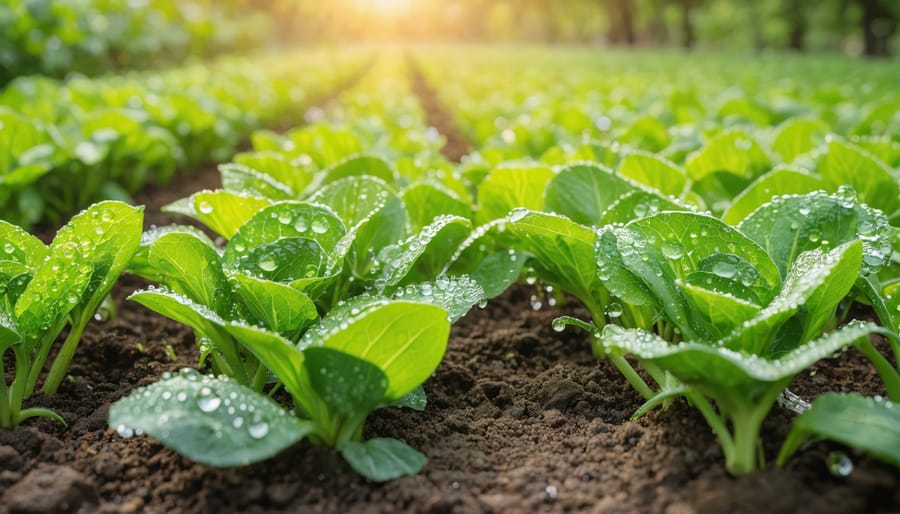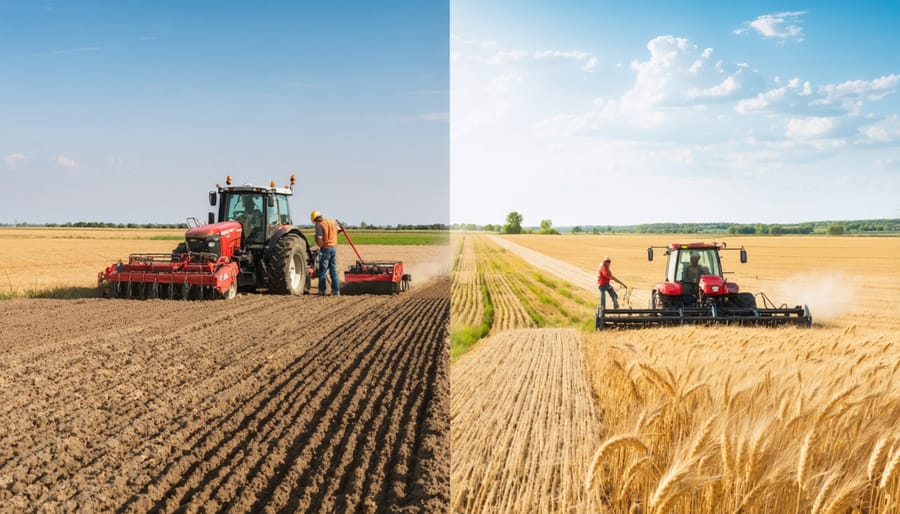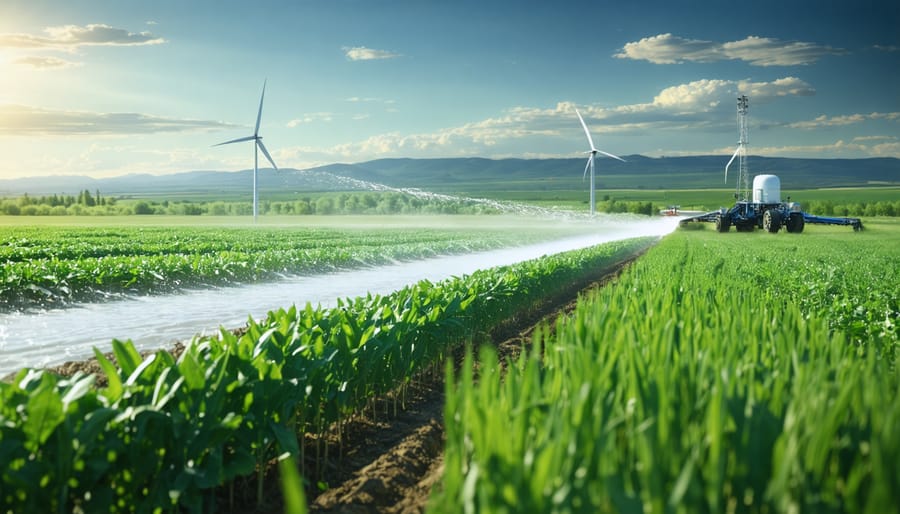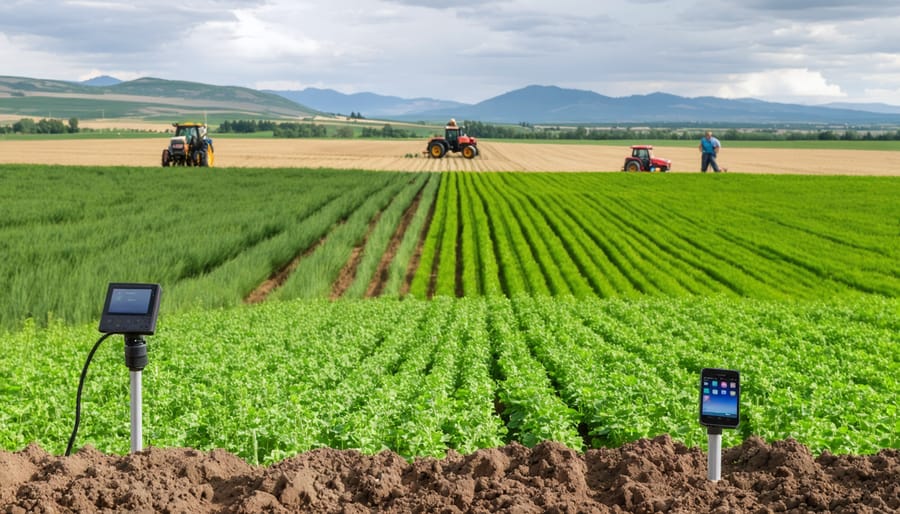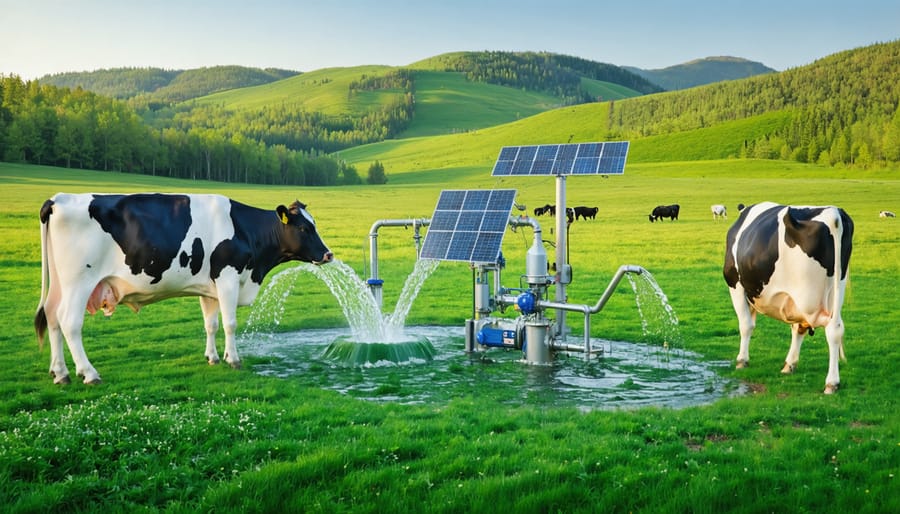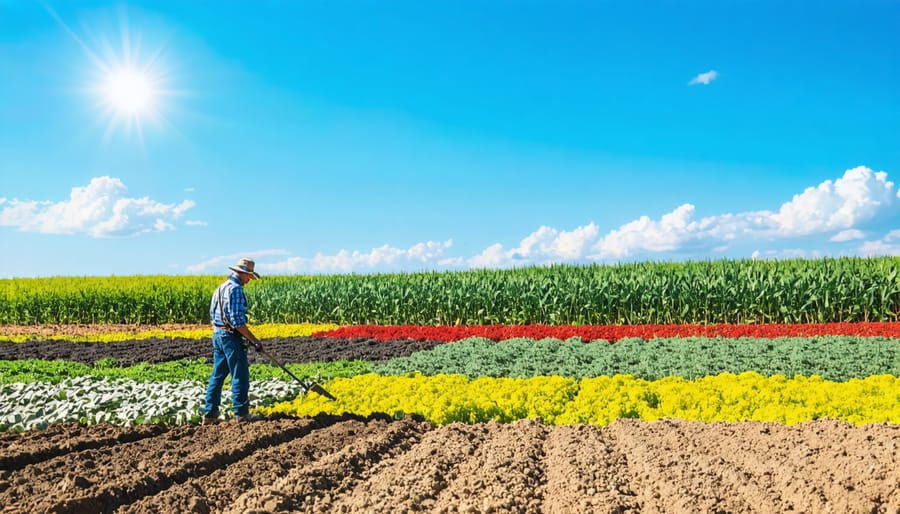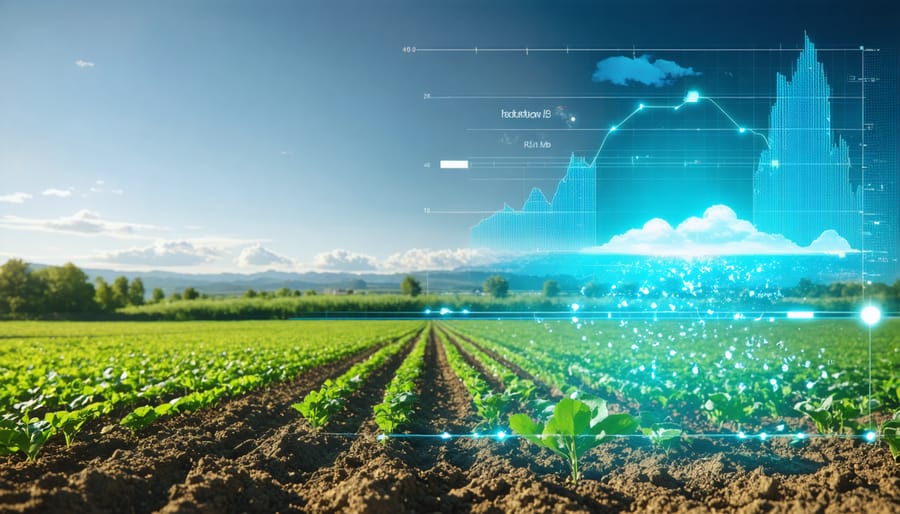Transform your farm’s water management with precision irrigation systems that reduce consumption by up to 40% while maintaining optimal crop yields. As water challenges faced by Alberta farmers intensify, innovative solutions like soil moisture sensors, drought-resistant crop varieties, and automated irrigation scheduling are becoming essential tools for sustainable agriculture.
Leading Alberta producers have already pioneered these water-smart techniques, demonstrating that strategic water management isn’t just about conservation—it’s about profitability. Through careful implementation of these solutions, farms across the province have reduced their water costs by an average of 30% while increasing crop resilience during dry periods.
From simple retrofits like low-flow nozzles to sophisticated systems that integrate weather data and soil conditions, today’s water solutions offer practical answers for every budget and farm size. These innovations don’t just conserve water; they provide precise control over one of your most valuable resources, ensuring every drop contributes to your farm’s success.
The Water Reality for Alberta Farms
Current Water Consumption Patterns
Recent data from Alberta Agriculture and Irrigation shows that our province’s farms typically use between 2,500 and 3,500 cubic metres of water per hectare annually, with significant variations based on crop type and local climate conditions. Traditional flood irrigation, still used on about 40% of irrigated farmland in southern Alberta, accounts for the highest water consumption rates, using up to 30% more water than modern sprinkler systems.
According to the 2022 Alberta Irrigation Districts Association report, the average farm in the Lethbridge region uses approximately 65% of its water allocation for crop irrigation, 20% for livestock operations, and 15% for other farm activities. However, these patterns are shifting as more farmers adopt precision irrigation technologies and drought-resistant crop varieties.
Weather pattern changes have also influenced consumption trends, with many farmers reporting the need to start irrigation earlier in the season. This shift has led to an average increase of 12% in water usage during the spring months compared to a decade ago, highlighting the growing importance of efficient water management strategies in our agricultural practices.
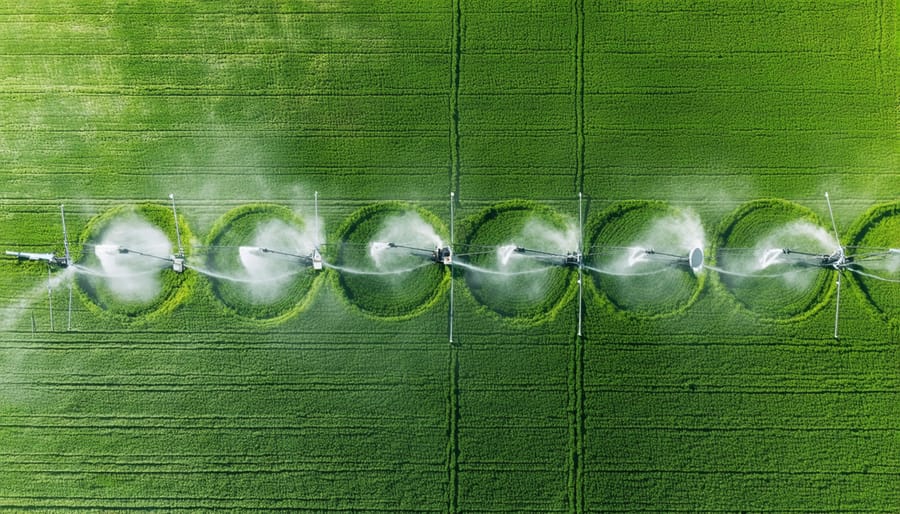
Economic Impact of Traditional Water Systems
Traditional water management systems in Alberta farms typically require substantial investments in infrastructure and ongoing maintenance. A standard pivot irrigation system can cost between $75,000 to $100,000 per quarter section, with annual operating costs ranging from $5,000 to $8,000. These expenses include energy costs for pumping, regular maintenance, and labour for monitoring and adjustments.
Many Alberta farmers report spending 15-20% of their annual operating budget on water management alone. Beyond direct costs, conventional systems often lead to hidden expenses through water waste, soil erosion, and reduced crop yields due to inconsistent irrigation patterns. For example, a recent survey of southern Alberta farms showed that outdated irrigation systems waste approximately 30% of water through evaporation and runoff, translating to roughly $3,000 in unnecessary water costs per growing season.
The labour requirements of traditional systems also impact farm economics significantly. Farmers typically spend 5-7 hours per week managing conventional irrigation systems during peak season, time that could be better invested in other farm operations.
Game-Changing Water Recycling Technologies
Greywater Recovery Systems
In Alberta’s agricultural landscape, greywater recycling systems are becoming an increasingly popular solution for water conservation. These systems capture and treat lightly contaminated wastewater from sources like sinks, showers, and laundry facilities, making it suitable for irrigation and other non-potable uses on the farm.
A typical farm greywater system can recover up to 70% of household water, translating to significant savings of 50,000 to 100,000 litres annually for the average farming operation. Local farmer Mike Thompson from Lacombe County reports saving nearly $2,000 yearly on water costs after installing a basic greywater recovery system.
The most effective setups include a three-stage filtration process: initial screening to remove larger particles, biological treatment using beneficial bacteria, and final UV disinfection. Modern systems also incorporate smart monitoring technology to ensure water quality meets Alberta’s agricultural standards.
Installation costs typically range from $5,000 to $15,000, depending on system size and complexity. However, many farmers find the investment pays for itself within 3-5 years through reduced water bills and increased crop yields. Provincial rebates and sustainability grants can help offset initial costs, making these systems more accessible to small and medium-sized operations.
Remember to check local regulations and obtain necessary permits before installation, as requirements vary by municipality across Alberta.
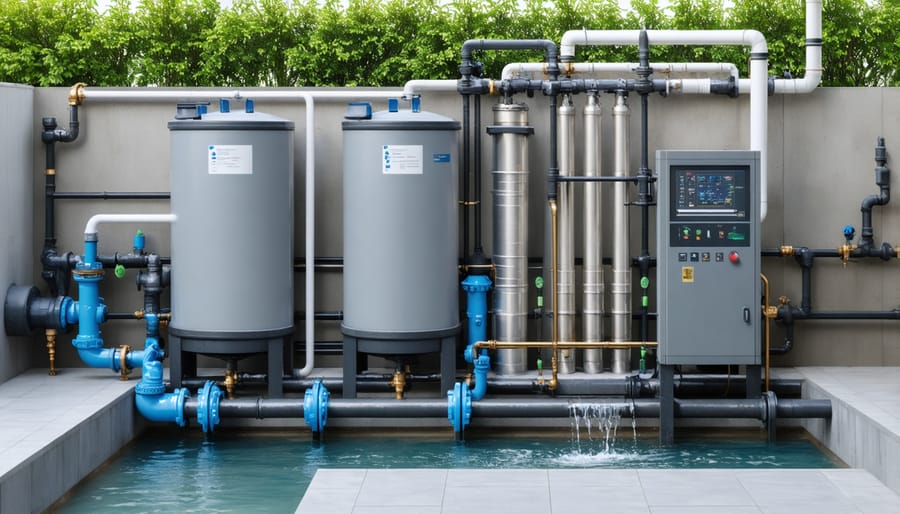
Advanced Filtration Solutions
Modern filtration systems have revolutionized water management on Alberta farms, offering solutions that go beyond traditional sediment removal. Today’s systems combine multiple technologies to deliver cleaner, more efficient water for agricultural use.
Multi-stage filtration systems, particularly popular among Lethbridge region farmers, incorporate both mechanical and biological filtration processes. These systems can remove particles as small as 5 microns while targeting specific contaminants common in Alberta’s groundwater, such as iron and calcium deposits.
Sand media filtration remains a cost-effective solution for larger operations, with updated automated backwash systems reducing maintenance time by up to 70%. Several farmers in the Red Deer area have reported annual savings of $3,000-5,000 in operational costs after upgrading to these systems.
Membrane filtration technology, including reverse osmosis and ultrafiltration, has become more affordable and energy-efficient. These systems are especially valuable for greenhouse operations and livestock facilities where water quality directly impacts production outcomes. Local success stories include a Mundare dairy farm that reduced bacterial counts by 99.9% using a combination of UV and membrane filtration.
For smaller operations, portable filtration units offer flexibility and cost-effectiveness. These systems can be moved between different water sources and typically process 2,000-5,000 litres per hour, making them ideal for seasonal operations or shared use between neighbouring farms.
Smart Monitoring and Control
Modern farming in Alberta is experiencing a digital revolution through smart monitoring systems that transform how we manage water resources. These innovative technologies combine sensors, automation, and data analytics to give farmers real-time insights into their water usage and soil conditions.
Local farmers like Dave Thompson from Lacombe County have seen a 30% reduction in water consumption after installing soil moisture sensors and automated irrigation controls. These systems send alerts directly to smartphones when soil moisture levels drop below optimal thresholds, allowing for precise irrigation timing and reducing water waste.
The technology isn’t just about water savings – it’s about smarter farming. Modern monitoring systems can integrate weather forecasts, crop health data, and historical usage patterns to make intelligent irrigation decisions. For example, the Southern Alberta Irrigation Project reported that farms using automated systems saved an average of 4,500 cubic metres of water per growing season while maintaining or improving crop yields.
Getting started with smart monitoring doesn’t have to be overwhelming. Many Alberta agricultural extension offices offer support programs and training sessions to help farmers implement these technologies. Some systems can be installed gradually, starting with basic soil sensors and expanding to full automation as comfort and needs grow.
Remember, every drop counts, and these technologies help ensure we’re using our water resources as efficiently as possible while supporting sustainable farm operations for future generations.
Real Success Stories from Alberta Farms
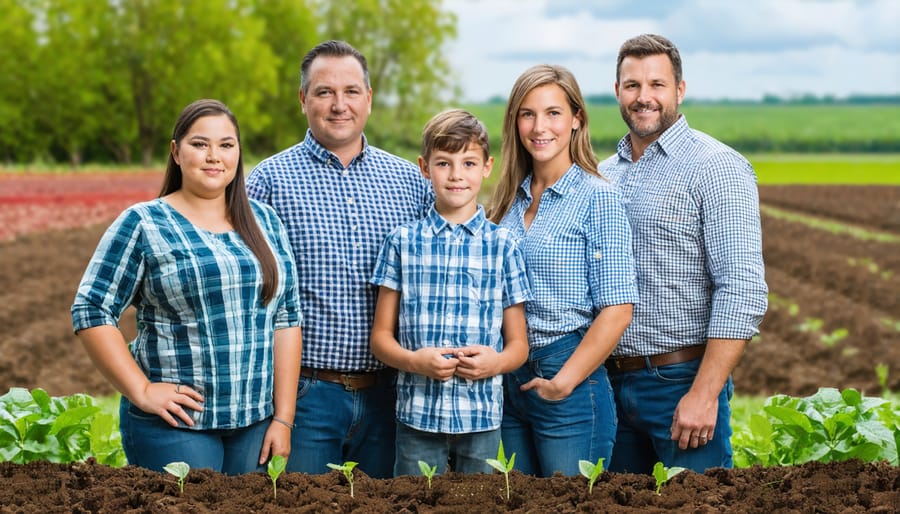
The Thompson Family’s Water Revolution
The Thompson family’s 400-hectare farm near Lethbridge faced a critical turning point in 2019 when rising water costs threatened their mixed crop operation. Sarah Thompson, a third-generation farmer, spearheaded the transformation of their irrigation system, implementing a combination of soil moisture sensors and precision irrigation technology.
“We were using nearly 30% more water than we needed,” Sarah explains. “The old sprinkler system wasn’t efficient, and we couldn’t track our usage effectively.” Working with local agricultural experts, the Thompsons installed smart irrigation controllers and soil monitoring stations across their fields, connecting everything through a central management system.
The results were remarkable. Within the first growing season, the farm reduced water consumption by 25% while maintaining crop yields. The new system automatically adjusts watering schedules based on real-time soil moisture data and weather forecasts, eliminating guesswork and overwatering.
The initial investment of $75,000 was offset by provincial rebates and water savings. “We’re seeing a return on investment faster than expected,” Sarah notes. “Our annual water bills are down by $12,000, and our crops are healthier because we’re watering more precisely.”
The Thompsons now share their experience with neighbouring farms, hosting regular workshops to demonstrate their water management system. Their success has inspired five other local farms to adopt similar solutions, creating a ripple effect of water conservation in the community.
Cooperative Water Management Success
In 2021, five farming families in Southern Alberta demonstrated how cooperative water management strategies can transform agricultural communities. The Larson, Miller, and Thompson families, along with two other neighbouring farms, pooled their resources to implement a shared irrigation system that serves over 800 hectares of farmland.
The group invested in a modern drip irrigation network, replacing their individual pivot systems. By sharing infrastructure costs and coordinating water scheduling, they reduced their collective water usage by 35% while maintaining crop yields. The partnership also allowed them to install water monitoring technology that would have been cost-prohibitive for individual farms.
Their success sparked interest across the region, with similar collaborations emerging in other communities. The group established a rotating schedule for water usage, ensuring fair distribution during peak seasons. They also created an emergency sharing protocol for drought periods, providing mutual support during challenging times.
The initiative went beyond water sharing – the families now coordinate crop planning to optimize water usage throughout the growing season. Their collaborative approach has saved each farm an average of $15,000 annually in water-related costs while strengthening community bonds and resilience in the face of climate challenges.
Implementation Guide: Getting Started
Assessment and Planning
Before implementing any water solution on your farm, a thorough assessment of your current situation and careful planning are essential. Start by conducting a comprehensive water audit to understand your farm’s current water usage patterns. Document your monthly water consumption, identify peak usage periods, and note seasonal variations that align with your crop cycles or livestock needs.
Walk your property to map existing water infrastructure, including irrigation systems, storage facilities, and natural water sources. Take detailed notes on areas where water waste occurs, such as leaky equipment or inefficient irrigation practices. Consider bringing in a local agricultural water specialist who can provide expert insights specific to Alberta’s climate and soil conditions.
Create a detailed implementation plan that includes both short-term and long-term goals. Break down your objectives into manageable phases, considering your budget constraints and seasonal farming operations. Priority should be given to solutions that offer the quickest return on investment, such as fixing leaks or upgrading to more efficient irrigation nozzles.
Remember to account for future expansion plans and climate variability in your assessment. Factor in the time required for permit applications and potential infrastructure modifications. Many Alberta farmers find it helpful to connect with neighbouring farms that have successfully implemented similar water solutions to learn from their experiences and avoid common pitfalls.
Document everything in a clear, organized manner that can be easily shared with team members and contractors. This will ensure everyone involved understands the objectives and timeline for implementing your chosen water solutions.
Available Support and Resources
Alberta farmers have access to numerous support systems and resources to help implement innovative water solutions. The Canadian Agricultural Partnership (CAP) offers grants of up to $100,000 for water efficiency projects, including irrigation upgrades and water conservation initiatives. Local Agricultural Service Boards provide free consultations and can connect you with water management specialists in your area.
The Alberta Irrigation Technology Centre in Lethbridge offers hands-on demonstrations and training sessions throughout the growing season. They maintain a network of demonstration sites where farmers can see different irrigation systems in action and discuss results with agricultural technologists.
The Environmental Farm Plan (EFP) program provides both technical assistance and potential funding opportunities. Through this program, farmers can access one-on-one support to develop comprehensive water management strategies tailored to their specific operations.
Regional watershed stewardship groups offer valuable networking opportunities and often organize workshops focused on water conservation. The Alberta Water Council maintains an online database of water management resources, including case studies of successful implementations across the province.
For immediate support, the Agriculture Water Specialists Hotline (1-866-882-7677) offers expert advice on water-related challenges. Local agricultural extension offices can also provide soil moisture testing services and equipment loans to help you get started with water monitoring programs.
By embracing innovative water solutions, Alberta farmers can lead the way in sustainable agriculture while protecting their bottom line. The benefits are clear: reduced water consumption, lower operational costs, improved crop yields, and enhanced drought resilience. Every step toward water efficiency, whether through precision irrigation, soil moisture monitoring, or water recycling systems, contributes to the long-term sustainability of our farming communities. As climate patterns continue to shift, now is the time to take action. Connect with local agricultural extension services, join farmer-led water conservation initiatives, and explore available grants for implementing these solutions. Together, we can build a more water-wise and prosperous agricultural future for Alberta, ensuring our farms remain productive for generations to come.


